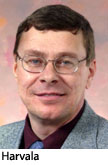The 100-some voting delegates to the LCMS North Dakota District convention, meeting Jan. 22-25 in Bismarck under the theme “Rekindle the Zeal,” re-elected on the first 
North Dakota was the first of the 35 Lutheran Church–Missouri Synod districts to hold conventions this year, as they do every three years.
Delegates also re-elected the district’s two vice presidents — Rev. Patrick O’Brien, pastor of St. John Lutheran Church, Oakes, N.D., first vice president, and Rev. Carlyle Roth, pastor of St. Mark Lutheran Church, Minot, second vice president.
Those elected were installed near the end of the district convention — including Harvala to his final three-year term, as allowed by the district’s constitution and bylaws.
Delegates also elected other district officers and adopted resolutions that call for increased mission outreach throughout the District, and authorized the district to submit an overture to the 2007 Synod convention “to encourage fair representation at Synod conventions” by assuring that only voting delegates from electoral circuits may vote at those conventions, with no exceptions.
Outreach-directed resolutions the delegates adopted include those that:
- encourage district mission-planning that uses, among other resources, those available through the Synod’s Ablaze! emphasis;
- ask congregations to share with each other their outreach activities in the next year and use a district “rural ministry idea bank” to discover “those ideas that may be utilized in their local outreach efforts, thus enhancing rural ministry ideas.”
- encourage congregations to ask members who are relocating within the district to “reconnect with LCMS congregations or ministries” and have congregations send referrals of those members to congregations where they are relocating; and
- urge congregations to utilize technology for outreach, including e-mail and the Web.
The resolution encouraging “fair representation at Synod conventions” notes that in 2003 the district reduced its number of circuits from nine to six, to comply with a Synod bylaw that stipulates the makeup of circuits, based on “aggregate communicant membership” of the congregations in the circuit. However, the resolution also points out that “many other districts applied for exemptions,” which another Synod bylaw allows.
It points out that “more than 12 percent of the delegates to the 2004 Synod convention represented circuits that did not meet the requirements” of the bylaw stipulating the makeup of circuits, “yet delegates were seated under the provisions” of the bylaw that allows exemptions.
That resolution calls for striking the Synod bylaw that allows exemptions, after it notes, “The granting of a large number of exemptions essentially disenfranchises those who voluntarily reduce their representation by adhering to the numerical guidelines of the bylaw.”
Other resolutions adopted by North Dakota convention delegates include urging congregations to:
- establish parish-nurse programs;
- look for ways that they and their members can help during times of natural disaster;
- increase mission giving each year for the next three years; and
- support full-time church-work students at Synod colleges, universities, and seminaries.
Among those who addressed the convention were Synod President Gerald B. Kieschnick, who gave his report on the Synod; Dr. Robert Holst, president of Concordia University, St. Paul, Minn., essayist; and Bible study leaders Dr. Ralph Mayan, president of Lutheran Church–Canada; and Synod First Vice President William Diekelmann.
Harvala told Reporter that delegates and convention guests “mentioned over and over again [to him that] they really liked the amount of time we spent in Bible study and the quality of the Bible studies and the essay presented. Many consider these to be the highlight of the convention.”
Posted Feb. 15, 2006
